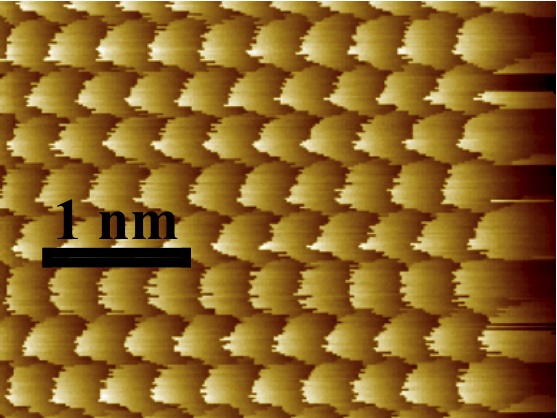
Téléchargez: thèse BILAS Philippe
Ce travail est une contribution à la comprehension des mécanismes de pertes d’énergie par frottement à l’échelle moléculaire.Les expériences sont réalisées avec un AFM/FFM.Les matériaux utitilisés sont des lamellaires:HOPG, NbSe2,mica. Dans le premier chapitre nous présentons une méthode originale mettant à profit la déformation du tube piezo électrique lors du balayage pour calibrer le microscope et obtenir un enregistrement continu de FL(FN) sur une image. Dans le deuxième chapitre nous faisons une étude des propriétés tribologiques à m »so échelle avec des vitesses de balayage de 30 m/s.Dans le cas de NbSe2 et HOPG le glissement a vraissemblablement lieu entre les feuillets.L’influence de l’atmosphère est interprété en terme d’épaisseur de film d’eau absorbé,plus important sous air que sous argon. Dans le troisième chapitre nous faisons une étude des propriétés tribologiques à l’échelle atomique avec des vitesses de balayage de 30nm/s et un mouvement de stick-slip de la pointe.La surface de mica en endommagée et concernant NbSe2 et HOPG les forces de frottement mesurées sont proche de celles obtenues à méso échelle.Il n’y a pas d’influence de l’atmosphère pour NbSe2. En conclusion les résultats sont discutés à partir des modèles de frottement existants.A l’échelle atomique le mécanisme dissipatif proposé repose sur le modèle de Tomlinson (dissipation d’énergie dans les phases non adiabatiques).A méso échelle le mécanisme dissipatif proposé repose sur le modèle de Postnikov (dissipation par vibration du système).
ABSTRACT
This work is a contribution to better understan the mechanims of energy loss by friction on a molecular scale.The experiments were carried out using an AFM/FFM microscopy and the materials used were lamellar:HOPG,NbSe2 and mica. In the first chapter,an original method was presented concerning the deformation of the piezo electric tube during the image scan to calibrate the microscope and obtain a continious recording of the FL(FN) curve in a full image. In the second chapter,the study of tribological properties at the mesoscale was investigated using scan velocity of about 30 m/s.In the case of both NbSe2 and HOPG, the friction was probably located between the layers.Measured on the mica, the high constraint was allocate to the large potential of interactions between the layers. The influence of the atmosphere was explained in term of film thickness of the absorbed layer of water, which are more important under air than argon. In the third chapter ,the study of tribological properties was investigated at the atomic scale using scan velocity of about 30nm/sand stick slip mouvement of the tip.The surface of mica was damaged and, for NbSe2 and HOPG, the mesured friction forces had close values those obtained at the mesoscale.Concerning NbSe2, there was no direct influence of the atmosphere. IIn conclusion, thes results were discussed from pre-existing models of friction.At the atomic scale,the proposed dissipative mechanism was based on Tomlinson’s model (dissipation of energy in the adiabatic phases).At the mesoscale, this mechanism was based on Postnikovv’s model (dissipation by vibration of the system).